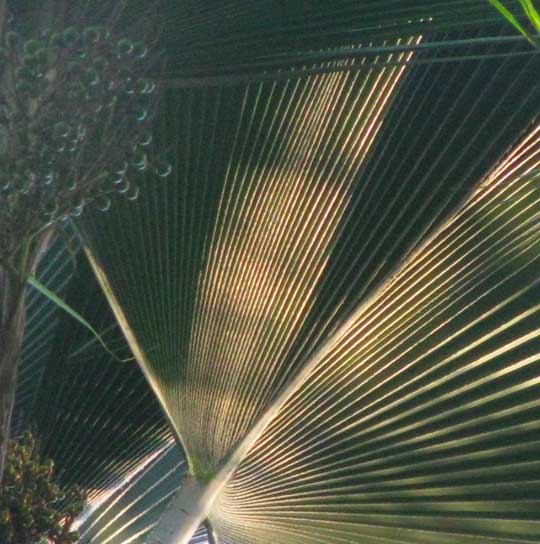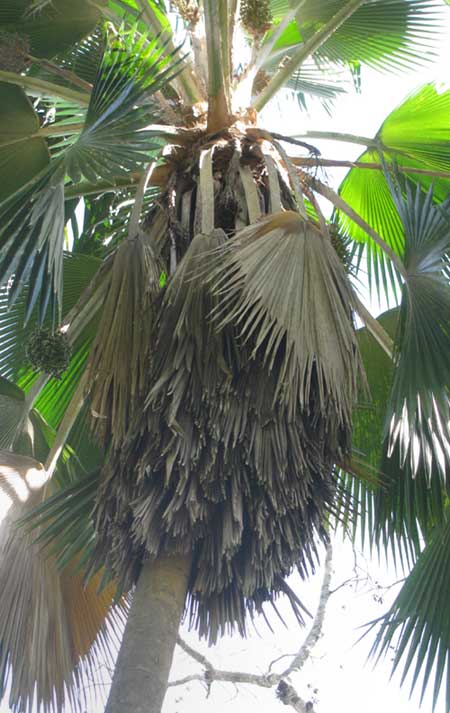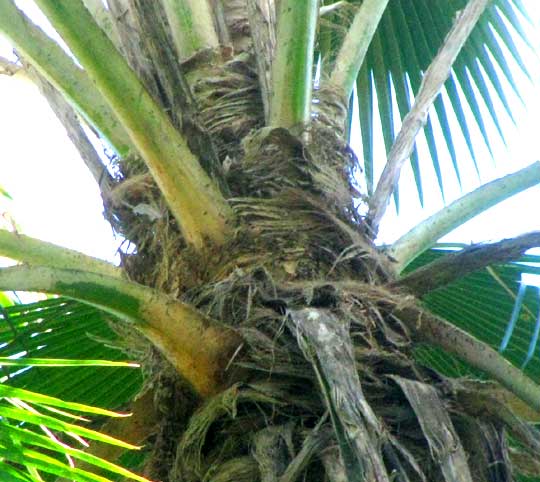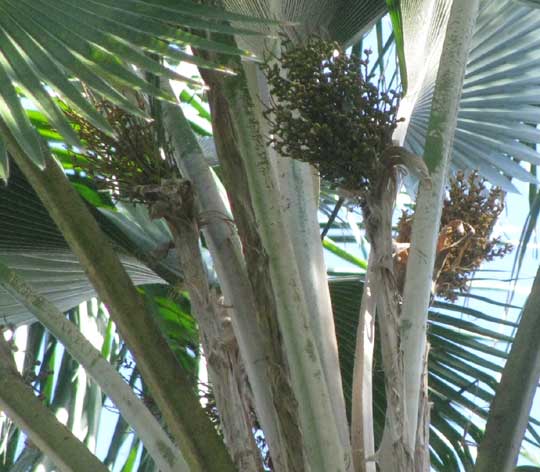Excerpts from Jim Conrad's
Naturalist Newsletter
from the March 25, 2012 Newsletter issued from Hacienda Chichen Resort beside Chichén Itzá Ruins; limestone bedrock; elevation ~39m (~128ft), N20.675°, W88.569°; central Yucatán state, MÉXICO
FIJI FAN PALM
For 2-½ years the identity of a certain palm at Hacienda Chichen has eluded me, pricking me with twangs of frustration each day I walk by it. You can see it framed by the trunks of two big Royal Palms below:

It's a fan palm -- one with fan-shaped fronds -- as opposed to the world's majority of palm types with feather-like blades, or "pinnately divided" ones. At first I thought the palm was just a shade-stunted Huano, or Thatch Palm, very common here. However, the trunk is much slenderer and the fronds are much flatter, less deeply incised, and arise from much slenderer petioles.
A feature separating blades of the Huano Palm from the similar Chit Palm, abundant along the Caribbean coast, is that the Huano frond's petiole extends as a diminishing midrib up into the frond, curling a bit at its end, and warping the frond downward. The minority of Fan-palms whose fronds have such curling midribs are said to be "costapalmate." Are our "shade-stunted" palm's fronds costapalmate? You can see that they are, with the petiole entering the picture at lower left, below:

The costapalmateness was more evidence that the mystery palm was just a sun-starved Huano. However, other features just didn't match. For example, the mystery palm's old fronds tended to dry out, droop, and form a "shag skirt" below the fronds, as shown below:

Huanos don't do that. Also, the bases of Huano frond petioles are broad and massive, and split down the middle. The shaded tree's petioles didn't split, as you can see below:

Moreover, you can see in that photo that petiole bases arise from a tangle of splitting, fibrous sheaths, which isn't the case with Huanos.
This week I noticed that the tree was fruiting, and that prompted me to try again at identification. This time I figured it out. You can see the fruit clusters below:

It's the Fiji Fan Palm, PRITCHARDIA PACIFICA, native to the Pacific islands of Tonga and Fiji, but planted in the tropics worldwide for its prettiness. I've seen it planted at another hacienda in the Yucatán, but I'd forgotten about it.
The genus Pritchardia contains 27 species, all native to Pacific islands. Hawaii is home to 22 species, of which eight are on the US Federal Endangered Species List. Pritchardias are closely related to our Huano Palms but distinguished from them by the field marks mentioned above. Pritchardia pacifica is the most frequently planted species of the genus.
Now that I know that our mystery palm is something different and special, and that it's the only one at the Hacienda, I'm struck by its handsomeness, and by how the wind causes its broad, stiff, kite-like blades to gyrate on their slender petioles.
Woodpeckers, by the way, prefer this palm's trunk over all others for drilling their nest holes.